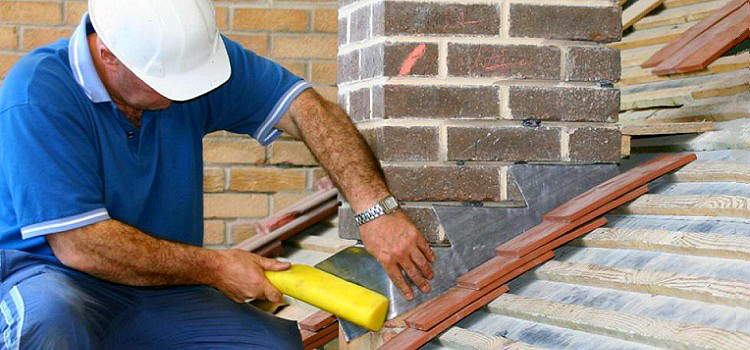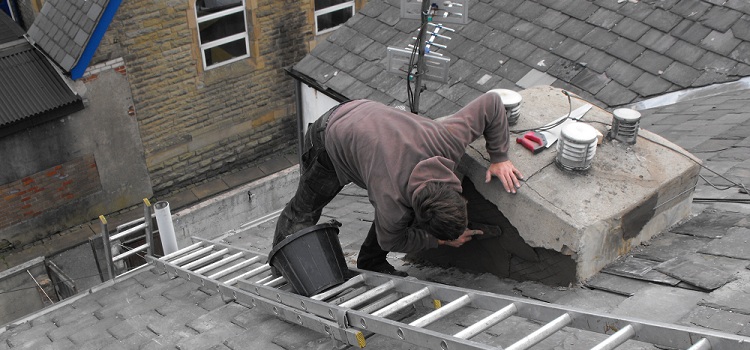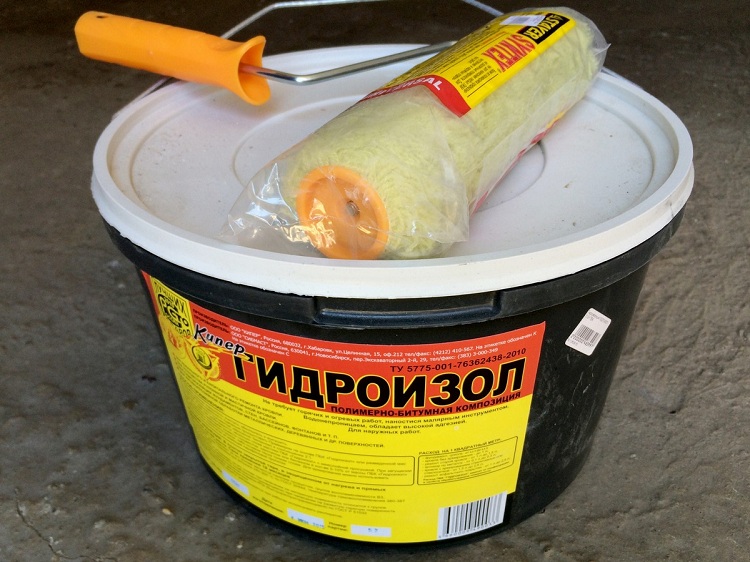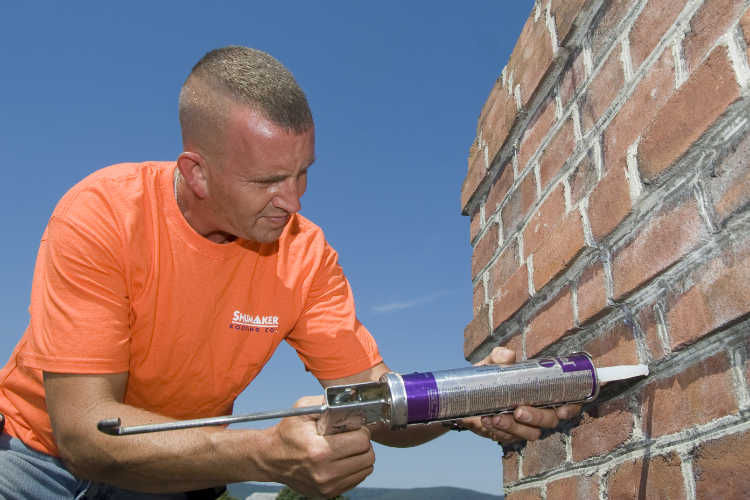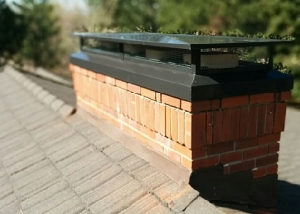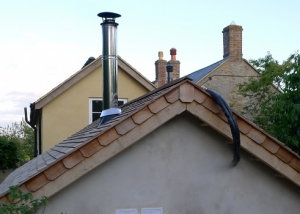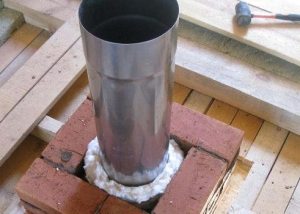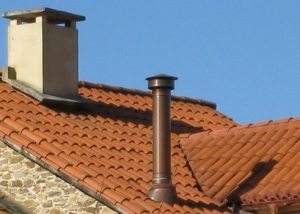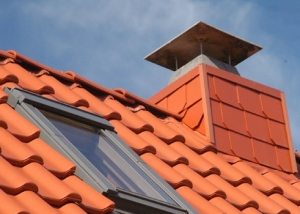Quite often, the places where chimneys exit to the roof are exposed to moisture, which accumulates in the unevenness of the roof after rainfall. This is because when installing pipes, all the necessary manipulations are not always performed or the rules for installing the chimney are not followed. In order to prevent such a problem, waterproofing is used when installing the pipe. An already installed chimney can be "saved" in the same way. The choice of the right materials, as well as the observance of the work technique, allows you to completely isolate the joints of the chimney from unwanted moisture and prevent premature destruction of it.
Content
Why waterproofing?
The waterproofing of the chimney is primarily a protective measure that prevents the roof from leaking. In addition, the insulation should, in principle, be present according to fire regulations, it performs a safety function, preventing possible ignition of the roof elements that are directly adjacent to the pipe.
Chimney waterproofing also increases the overall quality of the stove heating system. Without insulation, condensate usually flows down the walls of the pipe, which is a gross violation of the norms and generally an undesirable phenomenon. Among other things, the condensate evaporates when the furnace is heated, and thus creates an increased indicator of pressure in the pipe, which affects normal traction. Because of this, the quality of heating decreases. Over time, an increased rate of pressure in the furnace can cause the destruction of the chimney (especially if the walls of the chimney have cracks).
Another extremely negative factor for the chimney is the chemical compounds that are formed during the combustion of heating materials. As a result of exposure to high temperatures and moisture, which condenses when the chimney is not properly insulated, a chemical process of formation of active substances (alkali, acids, salts) occurs. These compounds "penetrate" into the walls of the pipe and destroy them.
Note! A very important point is that the formation and accumulation of condensate in the pipe can cause smoke in the heated room.
With proper placement of the pipe on the roof of the building, the complexity of the insulation work is minimized. To do this, you must first select a place for the pipe in advance and make the necessary calculations before installing it. The longer and smoother the chimney, the better its efficiency. As a rule, the best option for the location of the chimney is the place of the slope next to the ridge. Thanks to this placement of the chimney on the roof, the formation of snow pockets in the winter can be prevented. With this arrangement of the chimney, the roof is isolated at the exit channel.
Features of the choice of waterproofing materials
The first and, perhaps, one of the most important points when choosing materials for waterproofing works is the temperature at which fuel is burned inside the furnace. It must be considered when buying non-combustible thermal insulation for pipes.
Chimneys are made from the following materials:
- asbestos cement;
- ceramics;
- metal;
- brick with refractory properties.
The cross section that the chimneys have can be either square or rectangular. Sectional views affect the shape of the structure that will abut the roof. Not all taps are equally applicable to all types of furnaces and boilers, as different materials have different levels of resistance to high temperatures.
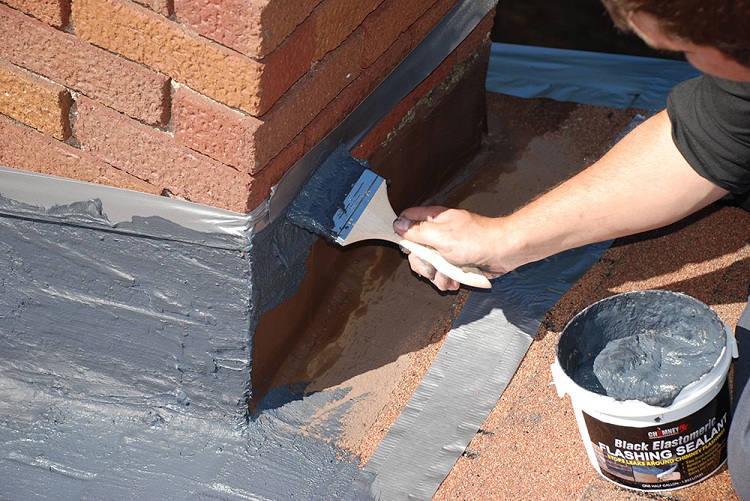
The material for insulation can be anything, the main thing is to follow the rules for its installation or application
Waterproofing a brick pipe or other pipe on the roof is not such a difficult process as it seems at first glance. The protective layer, which will prevent the ingress of moisture, is arranged in the form of layers. The material must necessarily have waterproof qualities, otherwise the insulation loses its meaning. In simple cases, the following materials are used as an insulating coating for roofs: glassine, roofing material or roofing. The laying of these materials is quite simple and is based on mastic or cement. In some cases, cement is diluted with the necessary additives to increase the reliability of such insulation. To preserve the heat in the pipe and improve heating qualities use a special insulation.
Important! In places that come into contact with roofing materials, according to the rules of fire safety, the temperature of the chimney should not be higher than 50 degrees. Brick pipes are a great option for absorbing heat.
For structures with increased safety requirements, the chimney is waterproofed using the following materials:
Bitumen insulating fabrics. Material represented by cotton, jute or asbestos fabric. During production, these types of fabrics are impregnated with soft bitumen, and a layer of refractory bitumen is applied on top (for strength and reliability). When laying them on the roof of the building, you need to ensure that the material lies evenly, without bends and folds. BIT is also used for plumbing joints.
Metalisol. This is a foil on which a layer of refractory bitumen is applied during production.
Hydroisol. This material is made of asbestos cardboard sheet, which is coated at the factory with bitumen of a certain brand. Metalisol is in rolls, as well as liquid. This material is an ideal solution for a chimney.
Important! The modern roof includes several layers that provide reliable and durable insulation from unwanted moisture penetration: insulation, waterproofing and vapor barrier. Proper installation of these protective layers protects the building from moisture, seasonal factors and helps to improve the heating of the house.
Borulina. It is made on the basis of a special mixture of dried asbestos and molten bitumen. This material is used in difficult cases - with an unsuccessful arrangement of pipes on the roof of buildings. It has a high waterproof rate and is also very ductile.
Requirements for Waterproofing Materials
Previously, a limited list of materials was used for waterproofing roofs and chimneys. The choice in the stores was not as huge as it is now, therefore materials that mainly remained after the construction of the building were used for waterproofing needs. Today you can choose any necessary materials that will help you to easily do all the necessary waterproofing work with your own hands. But thermal insulation for stoves and other pipes must pass according to all the necessary rules. Material for insulation work is selected taking into account the type of pipe and boiler.
Water resistance. Due to its location outside the building, a lot of natural factors influence the chimney (wind, rainfall, temperature drops, etc.).In order for them not to damage the insulation and not cause harm to the pipe, the protective material must be resistant to them and easily endure all natural whims.
Heat resistance. The chimney, carrying out its work, can be heated to high temperatures (500-600 degrees). Waterproofing materials, as well as heaters for stove pipes, protecting pipes from heat loss, must have high heat resistance, so as not to fail in such conditions.
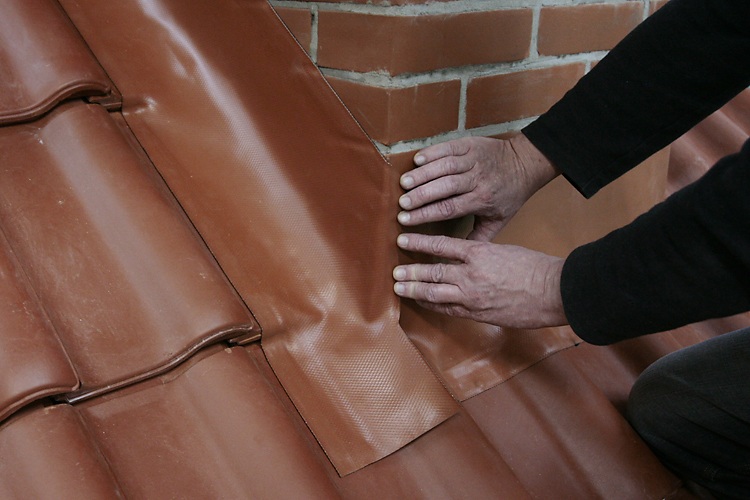
The type of waterproofing protection also depends on the type of roofing material that roofs are covered with.
Important! Waterproofing materials must be compatible with roofing. For ceramic tiles use galvanized ceramics, for soft tiles - bitumen elements, etc.
Wear resistance. Roofing materials, as a rule, have a life of 15 to 20 years. Auxiliary materials, which include waterproofing, must also be durable.
What tools are needed for waterproofing?
It is very important to remember the rule that conventional silicone-based building sealants should never be used in waterproofing work. These materials do not have the required characteristics to perform the insulation of the chimney.
All the necessary manipulations during the waterproofing of the chimney can be done using a set of tools, which includes:
- hacksaw;
- special brackets for installation;
- mineral wool;
- level and plumb;
- asbestos-based gasket;
- metal sheets;
- mastic;
- dowels;
- heat-resistant sealant;
- materials for thermal insulation;
- plaster mix;
- work gloves.
The main stages of waterproofing
All the work on waterproofing a brick pipe can be divided into 4 stages:
- To increase the adhesion between the wall surfaces, it is necessary to prime (bitumen in this case is more securely set). Then, using a bitumen-based mastic, a diffuse membrane is attached to the desired surface. The insulation material must be wrapped up at the edges and carefully put mastic on them. Such fastening, taking into account the correctly performed work, will ensure a reliable joint of the material with the pipe and prevent the leakage of water into the joint.
- Then you need to make and install in accordance with the rules of ties (lower and upper). Ties are made of metal corners. Sheets must be overlapped during installation to ensure that the liquid flows down.
- At the third stage, the corners of metal are attached to the battens and the pipe. For the connection, dowels are used. In the end, the joints obtained must be treated with heat-resistant sealant. To check the design, you can pour a little water on it, if leaks do not form anywhere, then the work was done correctly.
- The final step involves covering the entire previously mounted structure with web material. All joints must be processed with mastic based on bitumen. Then, special materials are applied to the structure in rolls. Joints are processed with bitumen based mastic. After that, a protective plastic apron is installed. At the very end of the work, the pipe is sealed with a special tape.
When working on the waterproofing of the chimney, you need to prepare and preferably consult with specialists. If you correctly approach the work, installation will not cause any difficulties. The modern market of building materials will allow you to purchase everything you need for insulation work on the roof of the building. To summarize the above, it is worth noting that only the right materials, selected specifically for your pipe, will provide its reliable protection against water.
